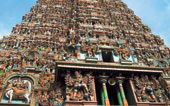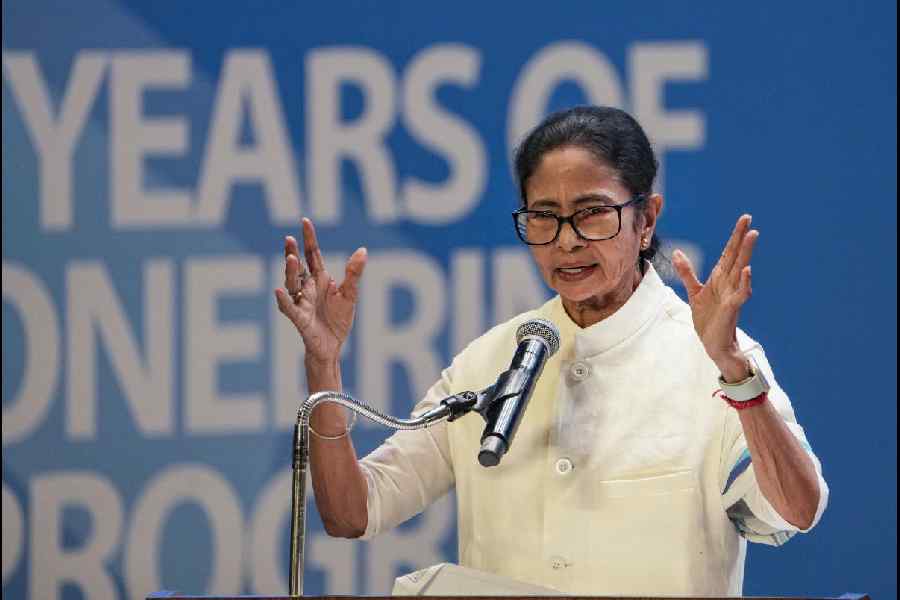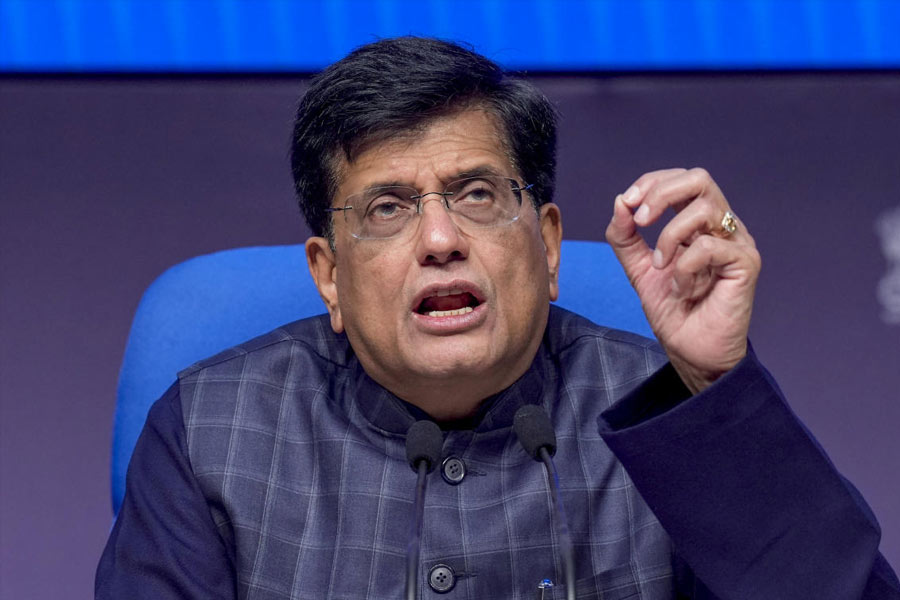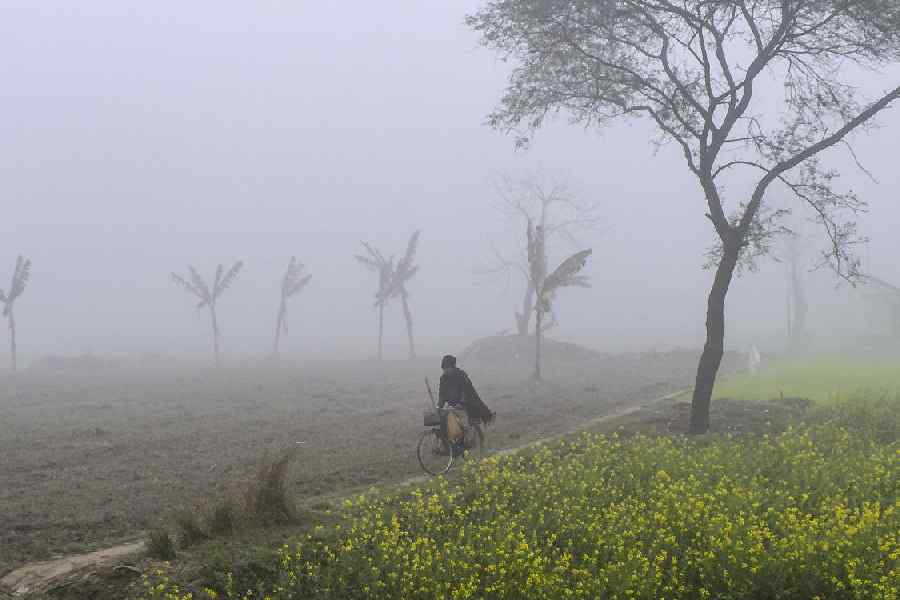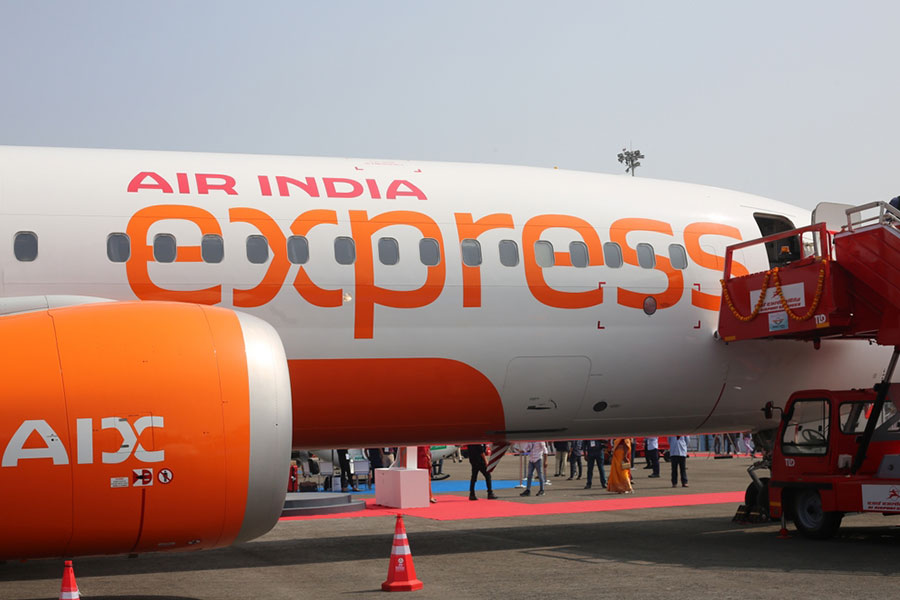 |
 |
| (Top): Exquisite carvings on the Meenakshi temple in Madurai and a temple complex in Kanchipuram |
A temple town is an important part of Dravidian history and culture ? a place where life has evolved and grown around a grand temple. Nowhere is this phenomenon more apparent than in Tamil Nadu where temple towns serve not only as important religious landmarks, but as social and commercial ones as well.
Visiting one is, in some ways, like slipping into a way of life that one would think is no more. At the same time, in other ways it is equally disconcerting, because a mile away from the temple, modern life intrudes in the form of yellow STD-ISD booths and cyber caf?s nudging each other on street corners, and women zipping past on two-wheelers. Yet, in spite of the E-pujas and the temple websites ? understandable in a land of techies ? the temples and the way of life continue to thrive in the Tamil heartland.
Madurai
Till the 14th century A.D., Madurai was the state capital of the Pandya Kings, who started building the Meenakshi temple which was ultimately completed during the reign of the Nayakkar kings between the 16th and 18th centuries.
Synonymous with the city are the Meenakshi Amman and the Sundareswarar twin temples. The Meenakshi temple complex is almost a city in itself and the temple a complex structure, with contributions from each dynasty and monarch that ruled Madurai. The temple complex extends over 65,000 sq metres. Lord Siva in his incarnation as Sundareswarar and his consort Meenakshi are enshrined in the twin temples. One of the most striking features of the temple is the ‘Ayiramkaal Mandapam’ or the Hall of Thousand Pillars, where each carved pillar is a work of art.
Among the other important temples in Madurai is the Thirupparankundram Temple, considered one of the six abodes of Lord Subramanya. A visit to the Thirumalai Nayak Palace is also a must.
Kanchipuram
This temple town has been in the news recently for all the wrong reasons, all to do with its seer, but the fact is that it houses one of the most beautiful and holy shrines of Hinduism, the Kamakshi temple and is steeped in history and heritage.
Kanchipuram is believed to have started life as the capital city of one of the lesser dynasties of southern India, the Thondai. The legend goes that Kamakshi (an avatar of Uma) offered worship to a shivalingam made out of sand here and gained Shiva’s hand in marriage. The temple is associated with the Shankaracharya movement and the Adi Shankaracharya of the 1st millennium CE. It covers an area of 5 acres and the sanctum is crowned with a gold plated vimanam.
The other important shrines of Kanchipuram are the Ekambreswarar temple, the Kumara Kottam temple and the Ulagalanda Perumaal temple. The place is also a shrine to commerce, especially in the form of Kanjeevaram sarees.
Tanjore
Thanjavur or Tanjore took shape around the Tanjore Brihadeeswarar temple built by the Chola king Raja Raja Chola. The shivalingam worshipped in this temple, its grand deity, is said to be the grandest and biggest in India. It is about 9 ft in height, 23.5 ft in circumference and is said to have been found on the shores of the Narmada river. To reach it, priests actually have to climb steps! The figure of Nandi the bull that guards the main entrance is also immense.
Its gopurams, or crowns, are each impressive works of art in the best traditions of South Indian art. Gopurams, as in most temples here, are covered with figurines of all the gods and goddesses in the pantheon. Interestingly, the main gopuram also has stone figures of the main architects of the temple.
The main temples inside the complex are the Murugan temple, the Anjaneyar temple, Varahi Temple, the Vinayagar temple, the Natarajar temple and the Karuvurar temple. In Tanjore, the Shivaganga fort and the royal palace are also worth a visit. Tanjore paintings, mostly reproductions and prints, also sell briskly here.
Rameshwaram
South-east of Madurai, on an island in the Palk Strait, is the temple town of Rameshwaram. According to a legend linked with the Ramayana, this is the place where Rama worshipped Lord Shiva to absolve himself of the sin of killing Ravana in Lanka. Considered the Varanasi of the south, Rameshwaram is a major pilgrimage centre for both Vaishnavites and Shaivites.
The main attraction is the 17th century Ramanathaswamy temple, renowned as much for its splendid architecture as the legend associated with it. The magnificent pillar corridor of the temple, running to a length of 1,200m, and flanked by ornate pillars is a sight to behold. There are 22 sacred wells in the temple, and it is said the water of each has a distinct taste.
About 100m away is Agnitheertham, the spot where Rama is held to have worshipped Shiva. At Gandamadana Parvatham, situated on the highest point in the island, is a shrine that has an imprint of a foot, held to be none other than Rama’s footprint. Dhanushkodi, at the eastern end of the island, is said to be the place where Rama bathed, and the boulders that dot the sea between here and Sri Lanka, geographically Adam’s bridge, are believed to be stepping stones used by Rama’s forces to cross the sea.
Rameshwaram, steeped in legends from the Ramayana, could well make one wonder why there was all that brouhaha over Ayodhya!
My favourite holiday
 |
Rachana Banerjee,
actress
I haven’t been on a leisure trip for the past 12 years, as my life has been a constant whirl of film-related work. But just some days ago, I returned from a trip of a lifetime to Kashmir — made all the more special by the fact that it was my honeymoon. My husband, Probal was leaning towards honeymooning abroad, but I managed to convince him otherwise.
You see, for a very long time, I’ve wanted to visit Vaishno Devi and thought it especially important to go there with Probal after our wedding for a blessing. And Kashmir being the closest tourist spot, we headed to its snowy locales after finishing our darshan.
Once there, we checked into a houseboat and spent all our time sight-seeing and basically having a great time. The views were spectacular and we visited Gulmarg, which was completely snow-covered and Pahalgaon. I also did a lot of shopping in Kashmir, picking up little odds and ends like wooden carvings and shawls. The one thing we didn’t do was sample any local Wazwan food — we preferred to stick with North-Indian cuisine.
Route map
If you’d rather not honeymoon overseas and are scouting around for domestic deals, there’s good news for you. Great packages have been put together by makemytrip.com, an online company that challenges you to find better pricing elsewhere. If you want to see Kerala close up, the 7-night and 8-day tour throws in Kovalam, Kumarakom, Thekkady, Munnar and Cochin for Rs 11,249 per person. The 5-night and 6-day Bangalore-Mysore-Ooty tour comes at Rs 9,100 per head while the 3-night and 4-day Srinagar-Gulmarg package is steeper at Rs 14,799. Another Kashmir tour that will take couples through Srinagar-Pahalgam-Gulmarg over 4 nights and 5 days has been priced at Rs 19,999 per person. While the packages are valid till March 31, 2006, they include accommodation on a twin-sharing basis, breakfasts, sightseeing as per the itinerary and transportation. But air or rail fares are not included in the deals.
Closer home, honeymooners can visit Darjeeling and Gangtok over 5 nights and 6 days for Rs 16,686 per person. But this package can only be availed of till December 31, 2005. Call: 1-600-118747 or 26533251 in Delhi or e-mail at honeymoons@makemytrip.com.

